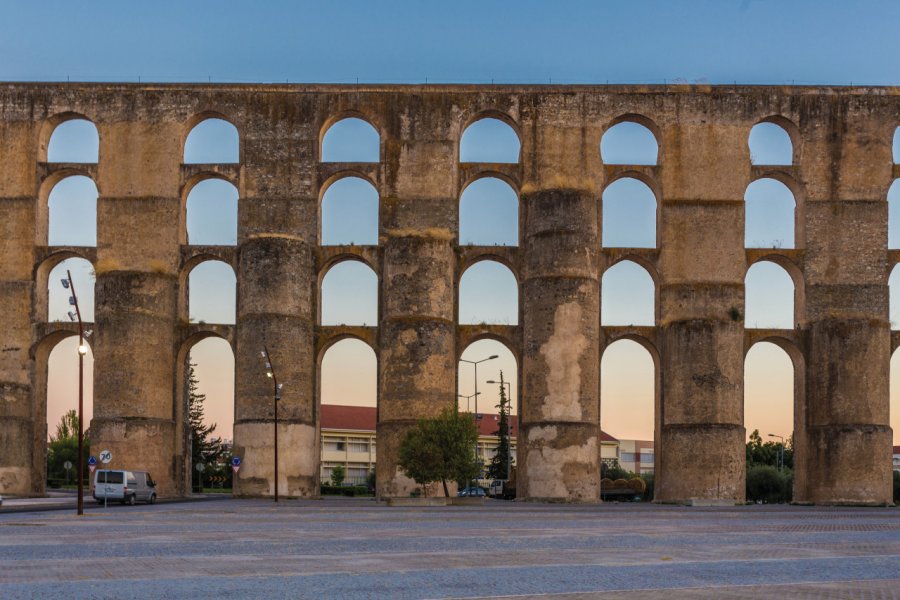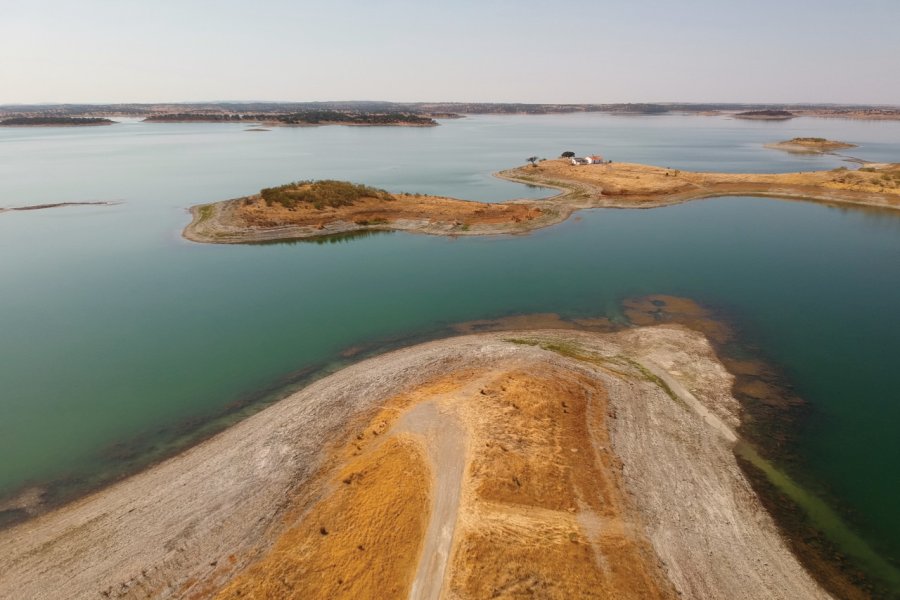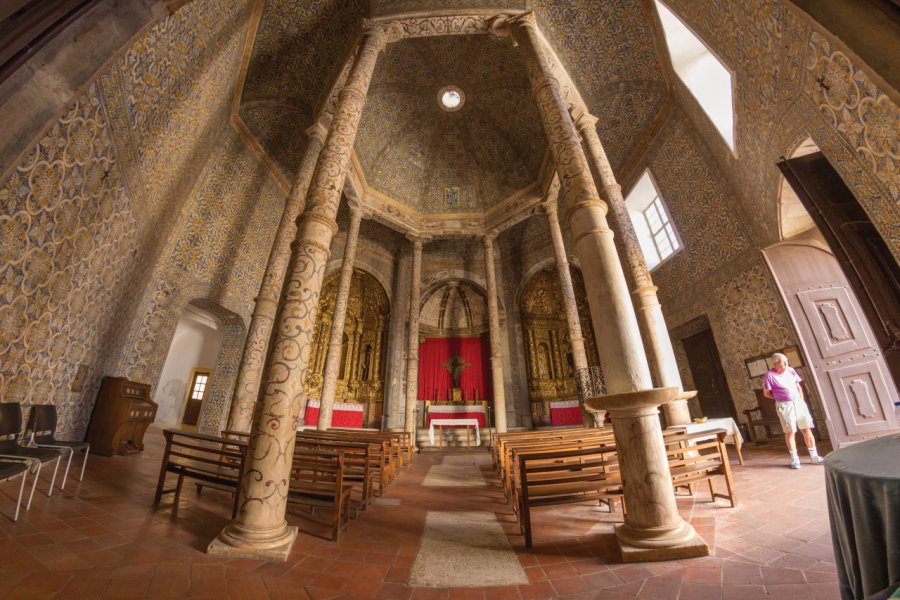Travel guide Alentejo
Among the five administrative regions of the Portuguese continent, theAlentejo is the largest and one of the most extraordinary. Still preserved from mass tourism, it allows you to spend a quiet stay, to discover authentic cities and preserved traditions, Portuguese gastronomy, but also to live great moments in the middle of nature. An unmissable destination during a trip to the Alentejo, Évora is the largest city in the region. Its historic center, its monuments from the Roman era and its medieval heritage have earned it a World Heritage Site. It rivals in beauty with Elvas, another listed and fortified city whose architecture of various styles is worth admiring. There are many other interesting towns in the region, such as Marvão and Castelo de Vide, where walks through the steep streets give way to moments of contemplation of the surrounding nature from the heights. For nature is also king and widely praised in all the tourist guides of the Alentejo, for the hikes to be made in the hilly and green landscapes of theSerra de São Mamede National Park, with its rich biodiversity, and for the escapades in the vineyards where to taste sweet fruity wines. The Alentejo is also about the beauty of the coastline and the Rota Vicentina network of trails that take walkers and cyclists to fishing villages, along steep cliffs battered by the ocean and wind, and to beautiful, unspoiled beaches where you can sit out of sight.
What to see, what to do Alentejo?
-
Book an activity
-
Customized travel
- The most beautiful cities Alentejo
When to go Alentejo ?
To the question: when to go to the Alentejo? Well, it is very easy to answer that with a Mediterranean climate, it is a destination where you can enjoy walking all year round. The best time to visit the Alentejo, to walk through the streets of its cities and to enjoy its nature is from May to October, when the sun shines generously. In spring, the shearing of the sheep invites you to discover the rural world; the flowering of the trees gives you the opportunity to go for a walk in a thousand colors; in late summer and early autumn, the tourists have left and you can discover the heritage in a calm environment, with mild temperatures and affordable prices. When to go to the Alentejo? Why not in the middle of summer! But then it's better to go to the coast to swim and cool off when the thermometer is over 35°C. The months of January and February can be good times to enjoy the gastronomy, but for the walks, don't forget to bring a sweater and a jacket. The cold and humidity also settle in the Alentejo in winter.
Suggested addresses Alentejo
Travel Alentejo
-
Find a hotel
-
Car Rental
-
International e-SIM package
-
Find a local agency
Et si l’Alentejo était le secret le mieux gardé du Portugal ? Et si, entre océan et montagnettes de la frontière espagnole se tenait le cœur du pays, une terre dont de rudes paysans ont extrait, des siècles durant, de quoi nourrir leur famille, contre les rigueurs du ciel et les affronts infligés par les grands propriétaires ? C’est ce à quoi l’Alentejo vous convie : un voyage d’histoire et de terroir. L’histoire pour la richesse des empreintes laissés par nos ancêtres préhistoriques, Romains, Wisigoths ou Maures… Le terroir pour les trésors qu’il procure : vin de toutes les couleurs, olives et huile, liège et marbre ; mais aussi figurines de terre cuite, sonnailles de cuivre, couvertures de laine, tapis d’Arraiolos… La terre est ici un somptueux terrain de jeu : parcs naturels, sentiers de randonnées, réserves pour l’observation des oiseaux… La mer, elle, abrite des cigognes dans ses rochers et des plages dignes du Pacifique…
Find unique Stay Offers with our Partners
How to go Alentejo
How to go alone
Those who wish to go to the Alentejo with their own car, it takes 16 hours to reach Évora from Paris. A shorter drive for those living in the southwest of France. By plane, it is possible to reach either Lisbon or Faro at interesting rates, especially in low season where a round trip in low cost costs around 80 €. Once at the airport, buses and trains allow you to reach the Alentejo for about ten euros.
How to go on a tour
Tour operators offer organized stays in the Alentejo region. It is also possible to create a customized trip according to your desires and interests. The agencies often propose trips between land and sea in order to discover all the richness of the region: the emblematic cities, the architectural heritage, the nature, its plains, lakes and vineyards, without forgetting the coast, between steep cliffs and wild beaches.
How to get around
In the Alentejo, those who do not have a car can travel by train; the cities of Évora, Elvas and Beja, in particular, have a train station. Many bus companies also cover the territory and prices are cheap. And if the desire for complete autonomy is stronger than anything else, there is always the possibility of renting a car to travel around the territory, either when you get off the plane in Lisbon or Faro, or in an agency in Évora.
Discover Alentejo
The Alentejo ("beyond the Tagus") represents almost a third of Portugal. Protected to the east by its many fortress towns, the region is dominated on its plain by the two sentinel cities of Beja and Évora. This rural province offers a complete change of scenery and the promise of a return to the land. Sparsely inhabited (6%), the region seems like an ocean of hills, with here and there a village or chapel punctuating the immense azure sky with the white of their walls. Here, you'll discover people, skills and a terroir that's still going strong. Alentejo is particularly renowned for its vineyards. It's also one of the regions where, on every street corner, you'll come across men and women sitting in the shade of a tree, almost part of the landscape. A word of advice: go outside the summer months. For example, in autumn, when the red-orange color of the vines blended with the brown-green of the trees and plains is marvelous.
Pictures and images Alentejo
The 12 keywords Alentejo
1. #Arbustus Unedo

The strawberry tree is sometimes called the strawberry tree, in reference to its pretty little fruits, whose shape is somewhat reminiscent of lychees... They are used to make jams, but are also used to make a rustic and subtle brandy: the famous medronho. A formidable brandy, but not to be abused!
2. #Bacalhau
Bacalhau is cod. A religion here. Bacalhau à brás is a flagship recipe, combining fish with eggs, potatoes, onions, garlic, black olives and parsley. Please note: brandade de morue is not a Portuguese speciality, but a... French dish from Nîmes (France)!
3. #Alentejano Mountain
It's a folk song from the Lower Alentejo region, sung by men's or women's choirs. It's a polyphonic song, classified as a UNESCO World Heritage Site. It's the song of the land, the song of the peasants... You're unlikely to hear it in concert, so it's up to you to find it at fairs, markets, late-night restaurants..
4. #Castles
In the eastern Alentejo region, along the Spanish border, almost every commune has its own castle, often in a well-preserved state. Portugal's history is marked by barbarian and Castilian invasions. Numerous fortified villages remain from this past, vestiges of a time when protection was paramount..
5. #Fado
Fado is a must in Portugal. This music often provokes a sort of "vague à l'âme" in those who let themselves be lulled by its sweet notes. It's an expression of saudade, a nostalgia that often speaks of love and exile. The famous singer Amália Rodrigues (1920-1999) helped fado to be heard the world over.
6. #Hospitality
Hospitality is omnipresent, but here it's coupled with great discretion. If you know how to travel, you'll be warmly welcomed. Many Portuguese have lived in France for many years, and often have family there: if you make the effort to say a few words in Portuguese, you'll sometimes be answered in perfect French!
7. #Markets

The Alentejo is full of beautiful markets, either in the open air or under a hall. The mercado municipal is the place to find all the local production, but also the heart of popular life. It is often lined with bars or pasteleria where it is good to eat, once the shopping is done. Vegetables, fruits, fish...: freshness is the order of the day.
8. #Maures
The influence of the Moors from North Africa has strongly permeated the region after five centuries of occupation. It is impossible to escape the testimonies of history, the vestiges and the heritage of this Muslim culture rooted in the Algarve, perceptible even in the language. A heritage that is celebrated during festivals.
9. #Montado

It is a particular ecosystem, formed by a pasture in sparse undergrowth, characteristic of the Alentejo. It is a municipal land area, a natural space created and exploited by man. An agro-sylvo-pastoral exploitation mode that exists since the Middle Ages, where the inhabitants can feed their cattle and harvest seeds and fruits..
10. #Mouraria
After the reconquest, a number of Moors accepted the standards imposed on them in order to remain in the country. This was the origin of the "mourarias", the Moorish housing areas that were once on the outskirts of the cities, but which today are part of them. These neighborhoods have kept their old typology, especially in Évora, Beja and... Moura.
11. #Mudejar

Mudejar is a Spanish word derived from Arabic, referring to the Spanish Muslims who became subjects of the Christian kingdoms after the 11th century. The Mudéjar style describes the combination of techniques and materials that reflect the influence of Muslim architecture on Christian buildings. The style developed from the 13th century onwards.
12. #Saudade
It is a word that is almost untranslatable into French. Like a nostalgia for the glorious time of the great discoveries, a kind of submission to fate, to the difficulties of life, a hope of returning to better days. It is the absence, the regret of what could have been or of what has been, the resignation in front of what can never happen...
You are from here, if...
You say good morning, good afternoon and good evening, not just "Olá". Even in everyday language, the Portuguese use this way of greeting. From midday onwards, or after lunch, we already say " boa tarde ".
At the crosswalk, you don't even think to look out for oncoming traffic. You know for sure that everyone on either side is going to stop!
You can sit for hours in front of a café or at home, watching life go by and nature come alive.
You regularly drop into a lucky house to buy a lottery grid, a Euromillions ticket or place a sports bet..
Soccer is in your blood. You don't miss a single match of your favorite club (Sporting? Benfica? FC Porto?) and you like to tease those who support a rival club, while the beers pile up on the bar.
You can't miss a single episode of your favorite telenovela, a soap opera with twists and turns as varied as its characters are cartoonish.
Other destinations Alentejo
- Évora
- Monsaraz
- Mértola
- Elvas
- Zambujeira Do Mar
- Vila Nova De Milfontes
- Portalegre
- Porto Covo
- Serpa
- Marvão
- Beja
- Estremoz
- Comporta
- Arraiolos
- Sines
- Vila Viçosa
- Castelo De Vide
- Mourão
- Reguengos De Monsaraz
- Castro Verde
- Santiago Do Cacém
- Alcácer Do Sal
- Campo Maior
- Moura
- Monte Redondo
- Portel
- Póvoa E Meadas
- Reserve Naturelle Do Sapal De Castro Marim
- Grândola
- Avis
























